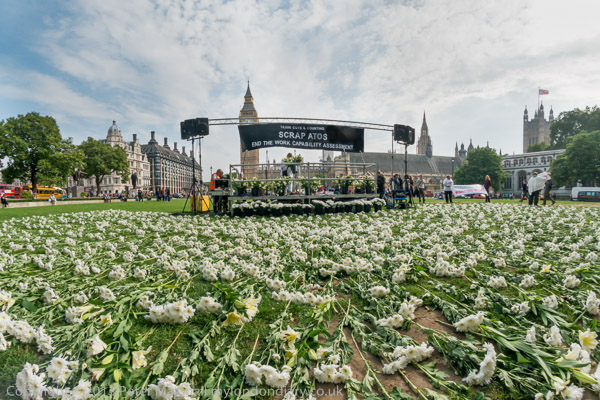
Although it felt rather like a demonstration, ‘10,000 Cuts & Counting‘ was described as ‘a ceremony of remembrance and solidarity’ with the many sick and disabled people who in the last few months of their lives were called in for Work Capability Assessments carried out by Atos on behalf of the Department of Work and Pensions.
Most knew they had only weeks or months to live, and doctors were well aware, but still they were called in for tests to see if they were ‘fit to work.’ Imagine the stress of having to attend the tests – and for many the real physical difficulty too. But even worse, many were judged fit to work on the basis of a computer-based questioning based on capabilities such as being able to sit in a chair, walk a few yards, press a button, lift a book… Those administering the tests for Atos are trained to catch people out and to reach their targets for cutting down the number of people who qualify for benefit. Many of those 10,000 will have lost their benefits – including some who will have lost them at the previous test and successfully appealed against the result. The system is inhumane and administered by a company that gets paid more the more people it fails. Neither the Government nor Atos appear to have any concern about the effect the tests have on those who undergo them.
There were some harrowing stories from many of the speakers about their own experiences and those of other disabled people under the system, but I couldn’t help feeling that it was preaching to the converted. Most of those who attended were already actively involved in campaigning and protesting over the issues involved. On a Saturday morning there were relatively few others in Parliament Square, and the four great institutions surrounding it, to each of which at one point we faced and made a plea – the Houses of Parliament, Westminster Abbey, the Supreme Court and the Treasury – were all largely empty, other than for the tourists queuing for the Abbey.
I thought a little about how I could make the most of the carpet of white flowers covering the grass of Parliament Square in front of the platform, and working from close to the front with a wide angle seemed to be the answer. I got down on my knees – you can tell photographers by the worn and dirty patches on their knees – and tried the 16-35mm, but it wasn’t really as wide as I wanted. The answer – yet again – was the 10.5mm fisheye, being very careful to keep the horizon level on the dead centre of the image. And afterwards it is just another plug for that Fisheye Hemi plugin.
The 16mm covers around two thirds of the view of the fisheye, but even if cropped to the same stretch of the buildings on the horizon, there is a subtle difference, and the flowers in the version from the fisheye don’t have the slightly disturbing elliptical aspect that a rectilinear ultra-wide produces at the edges. Despite the curvature of the straight gantry above the platform with the ‘Scrap Atos’ banner, and of the roof of the Houses of Parliament behind, the fisheye view actually appears more natural.
One problem with using the fisheye is flare and ghosts, and with a lens with such an extreme angle of view it isn’t possible to use a lenshood. There is a little lip around the lens, but that serves more to protest the glass than to shade it. Sometimes the effect adds to images, but more often it is a distraction. Probably it would be possible to retouch the lighter area at the upper right of the banner completely, but I simply darkened it a little. The sun was I think just outside the frame at top right, and you can see the effect of flare in the Victoria Tower and the trees at right of picture. The whole area needed darkening and also some increase in contrast.
Otherwise, the flowers made it rather difficult to cover the event, and kept the audience at rather a distance from the speakers, though it was actually much closer than the top image makes it seem. Photographers couldn’t easily photograph them either, as the flowers went right up to the platform.
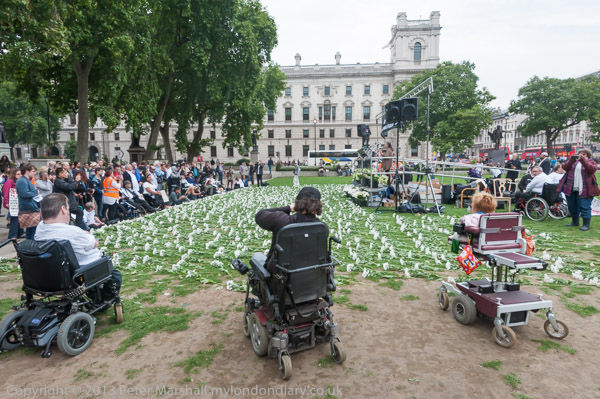
This isn’t a great picture, taken with the 16-35mm at 22mm, but it perhaps gives a more accurate idea of the area covered by the flowers (though perhaps making it look a little smaller than it was) and clearly shows how they made a ‘no go’ area for photographers at the centre of the event. It accounts for me taking a third of the photographs that morning with the 70-300mm, usually a lens I use rarely if at all.
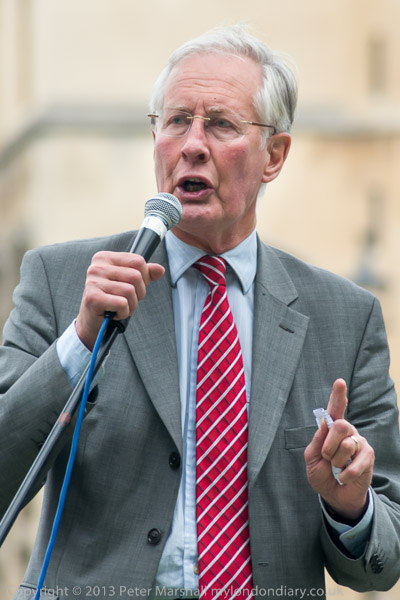
I wouldn’t have chosen to take Michael Meacher MP – one of a small number of MPs who have consistently stood up for disabled rights (two others, Jeremy Corbyn and John McDonnell were also present) – at 300mm (450mm equiv), the kind of focal length best reserved for bird spotters, and it would have been good to have been able to get a tighter image. I was able to photograph him – and the others involved, such as David Ison, the Dean of St Paul’s Cathedral who chaired the event , from a much closer distance talking to people.
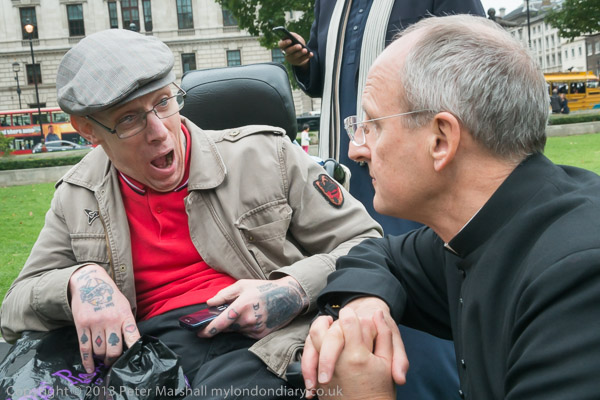
Most of the pictures in ‘10,000 Cuts – Deaths After Atos Tests‘ were taken either before the event started, when the audience were spaced out more widely and it was possible to walk up to them, or around and behind the stage.
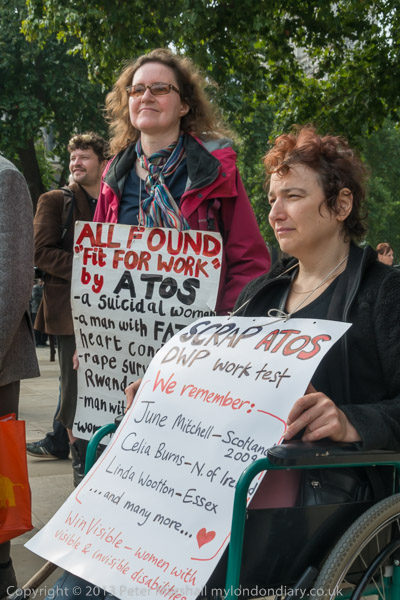
______________________________________________________
My London Diary : Buildings of London : River Lea/Lee Valley : London’s Industrial Heritage
All photographs on this and my other sites, unless otherwise stated, are taken by and copyright of Peter Marshall, and are available for reproduction or can be bought as prints.
To order prints or reproduce images
________________________________________________________